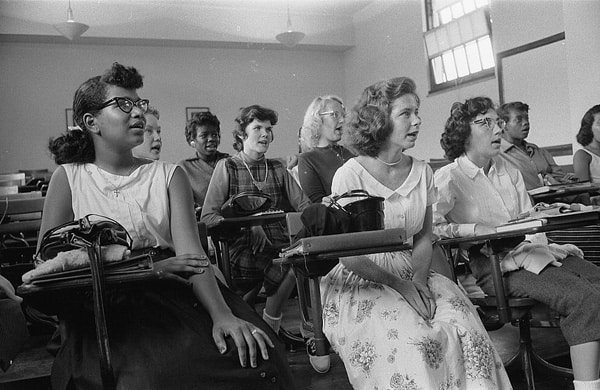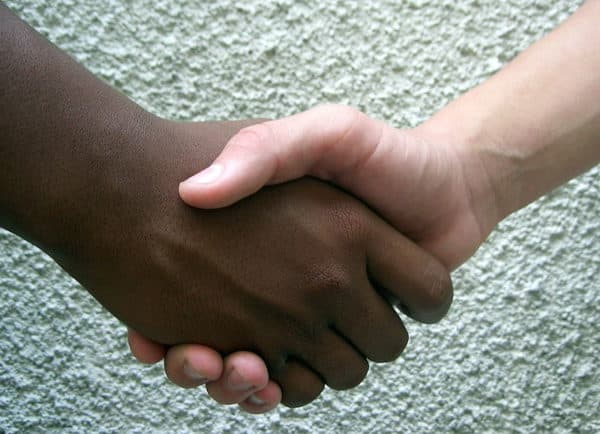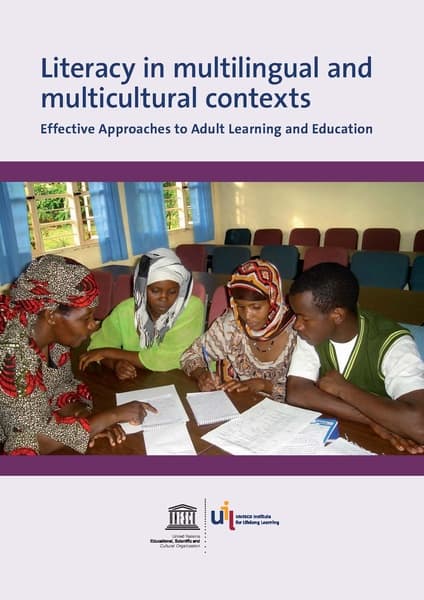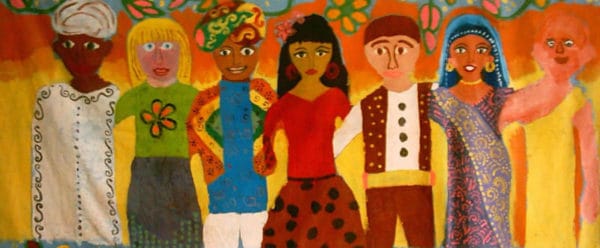After Twenty Years Working in Multiracial Public Schools, a White Teacher Tells All
Jane Moss, American Renaissance, May 12, 2020

I began teaching 20 years ago at a majority-black public middle school. The behavior of the black students was so outrageous, it bordered on unbelievable. Their respect for authority and teachers was less than nothing. They would pull my hair to see if it was real, sometimes standing around me playing with my hair like animals performing grooming rituals. Other times, they would push their faces into my abdomen, take a deep breath, and comment on the way I smelled. I’ve even had students tell me they could smell my “coochie” and shove their hand between my legs from behind.
They stole anything that was left on the desk without a hint of shame. Once, I had my toddler’s toy cell phone on my desk because I was repairing the antenna that had broken off it. When class started and students filed into the room, the cell phone was instantly swept away. At the end of class, a black student came up to me, dropped the toy phone on my desk and demanded to know, “What’s this!?” He was angry that what he had stolen from me was not a real phone.
Even things of almost no value got stolen: one time a student pumped the entire contents of the lotion bottle on my desk into a plastic bag to take home. Theft increased in December, as the black students began their Christmas shopping at the expense of the teachers. Wallets, tablets, credit cards, and cash were all up for grabs if you carelessly left them in an unlocked location. Their penchant for stealing was matched by one for destruction. My car was vandalized in the school parking lot several times, and on occasion, students would draw on the back of my clothes with markers as I walked by their tables.
Their attempts to get me fired were relentless. Students would rock back and forth in their chairs screeching angry monkey sounds in an attempt to trick me into saying the word “monkey” so they could accuse me of racism and end my career. The same tactic was in play when they said “nigger” over and over again. If I asked them to stop saying “that word,” they would reply “what word?” hoping I would repeat it. Of course, they had no real issue with profanity. One of their strategies to break the morale of teachers was to leave little pieces of paper all around the room with only the word “bitch” written on them.

An integrated classroom at Anacostia High School, 1957. Today’s multiracial classrooms aren’t picture perfect.
Violence was constant as well. I could list dozens if not hundreds of fights and random acts of brutality. Here are just a few.
Once, a new Haitian student who spoke no English was lured into an unmonitored hallway by three American blacks who then beat her unconscious. They slammed her head against a concrete stairwell repeatedly, fracturing her skull and one of her eye sockets, leaving her with partial, but permanent, vision loss.
Another time, a black girl picked up a chair and swung it into her black friend’s head simply because she “wanted to know what it felt like” to do so.
Perhaps worst of all was the time I saw a group of blacks drag a small white boy into a storage closet, with scissors at his throat the whole time. I nearly lost my job because I used a curse word in order to gain control of the situation, while the scissor-wielding thugs faced no consequences whatsoever. Although the administration was unhappy with my behavior that day, it impressed my students. My quick intervention and harsh language was met with cheers and applause because it was so striking to see a white teacher act so fiercely and decisively. Some students commented that what I had done to save the white boy was “so ghetto,” because I managed to be the dominant figure in the situation. On this occasion, they meant “ghetto” as a compliment. It doesn’t always carry a good connotation, though — the bastardization of my ancestors’ language is fluid.

Not a common sight. (Credit Image: Rufino / Wikimedia)
The victimization of whites by blacks is especially bad in middle schools because black children reach puberty earlier than their white peers, and are therefore much larger. Prepubescent white children generally adopt one or more of these three survival strategies:
- Remain small, invisible, and compliant. Try not to speak or be seen. This works fairly well as long as they are willing to periodically do classwork for blacks and not quibble when blacks “repossess” their property. Surrendering candy, sparkly pencils, fidget spinners, and the like are all common ways of paying the informal “white tax” that blacks enforce.
- Adopt ebonics and behave in a desperate and exaggerated ghetto style to try to and fit in.
- Deny their whiteness. Regularly find ways of announcing that they aren’t really white because they are Italian, or Jewish, or Spanish, or anything else that could possibly be construed as non-white.
These strategies do help, but not that much. In the end, all white students are made to suffer by their non-white counterparts — especially the small and quiet ones.
My proudest accomplishment was helping Michael, an upper-middle-class white boy, escape that middle school. He was only there in the first place because his family had recently moved to the area and enrolled him in the local public school without realizing what that would entail for their son. He was a model student. Every day he would sit quietly doing his assignments, periodically sighing as the rest of the class fought, bickered, yelled, cussed, vandalized, and cat-called one another.
One day, I sat down next to him and told him: “Go home and tell your parents to put you in private school, you don’t belong here.” His parents did so almost immediately — I’m so grateful they listened to me and had enough money to do something about it. I later learned that despite his straight-As at public school, he had to take a year of remedial education at his private school in order to catch up with his class. Imagine how much further behind he would have fallen if he’d stayed in my school much longer. The day after Michael left, teachers got an email from the administration telling us that under no circumstances were we to write letters of recommendation for students to get into private schools. You see, it is the few students like Michael who hold up the district’s test scores, making them a rare and valuable commodity not to be given up.
Looking back over my career as a teacher, the most striking change I have seen is the demographic one. The high school I teach at now used to be predominantly black, with small numbers of the other races. Now it is only about half black, with a swelling Hispanic population. As I sit at my desk reviewing student data, I see that one of my Latin American students has turned twenty. Carlos is a full grown man, but he is attending public school as a tenth grader to evade immigration enforcement. His presence is welcomed and even celebrated by the school administration and sanctioned by district officials in this large sanctuary city inside a sanctuary state. This high school is fairly large — with over 2,000 students — and there are two others about as big nearby, meaning that Carlos is not the only illegal alien taking advantage of the fact that Immigration and Customs Enforcement (ICE) does not raid schools.
Roughly 40 percent of the student population is now composed of “English language learners.” Many of these students are illegals who seem to have been bussed in by some sort of underground network. Most of them arrived in the past two years. Their families receive city services such as welfare, food stamps, and Section 8 Housing. At school, they get free breakfast and lunch and are given backpacks filled with food to take home over the weekend, along with “reproductive services,” psychologists, social workers, and specialized teachers to help them learn in their own language — all free of charge. The adults — parents or otherwise — get free evening classes in the same school to teach them English and how to find resources within the community.

An increasingly necessary guide published by UNESCO
The district is failing financially — buckling under the weight of all of these non-taxpaying students — and has started making cuts to staff and programs alike. Meanwhile, administrators are reaching out to the private sector for donations and the local government for tax hikes, all to prop up the overburdened system. The children of American citizens fight for placement in classes because there aren’t enough teachers to accommodate the ever-growing population of non-white freeloaders.
In return for the generosity of the community, the school now has Hispanic students lining the halls making out — and sometimes doing much more than that. The girls all want to get pregnant, and their culture cheers them on, regardless of their age or marital status. The boys carry knives and sell drugs, the stench of marijuana is ever-present in the hallways — which is where Hispanic students spend most of their time, as opposed to the classrooms they should be seated in. They refuse to speak English, claiming not to understand when told to go to class, and cussing out teachers in Spanish whenever they feel like it. Some even try to threaten teachers to get passing grades, making comments such as, “Do you like your car? I need an A.”
Other students rarely attend school but stay formally enrolled so they can be considered “DREAMers.” Their presence on the roster keeps other pupils from enrolling in a class they may need in order to graduate. Plenty of students openly state that they are only in school to get money and benefits, and to eventually take back the country that white people stole from them. Unsurprisingly, all but a few refuse to stand for the pledge of allegiance.
Hispanics are not the only new group in my school. There is also a modest population of Muslim “refugees” from the Middle East. Muslim students are better behaved and more academically adept than the illegals from Central and South America, and generally stick to themselves. They are far from perfect, though. From time to time you can overhear them talking in sympathetic tones about Islamic Fundamentalists, and how white girls are fun to have sex with, but should never be considered as a possibility for a girlfriend or a wife.

The reality is as bad as the art.
Racial tensions are always high at my school, and sometimes they explode. Not too long ago, the school caught wind of a group of black students planning a food fight after they advertised the event on Snapchat. In response, security was beefed up and announcements were made warning students not to participate in it or face consequences. This made no difference whatsoever. The battle was kicked off by a black teenager who threw a full can of soda at a school police officer, knocking her out cold. He high-fived his black friends when she hit the floor.
As food began flying through the air in every direction and fist-fights broke out, the nearly 1,500 students in the cafeteria spilled out into the hallways and then out of the building. En route, a substitute teacher was knocked down and trampled, earning her a broken leg. In my wing of the building, the one white security guard and I sent the students who were trying to escape the violence — most of them white — into my classroom to hide. Order was only restored when the SWAT team arrived.
To be fair, mass violence like that food fight is not a weekly occurrence, and isn’t as frequent as it was years ago when blacks were still in the majority. Fights generally happen on a much smaller scale, usually when a small group of students walks into a classroom, yanks a student out of his chair, and start beating him. You could say the school is a constant example of “Murphy’s Law” — anything that can go wrong, will go wrong. Every week, there are several instances of open drug use, littering, stealing, smashing mirrors, graffitiing, breaking toilets off the walls, spitting in the hallway, urinating in public, and smearing feces on the bathroom walls. If it can be broken, it will be. If it can be stolen, it will be.
The “outrage culture” the school is steeped in makes everything worse. Black teenagers are well versed in their victimhood status, and accusations of “racism” are never ending. If you are older and white, students assume the worst of you and go out of their way to disrupt your classes and say outrageous things about white people in order to provoke you. They are always trying to make you lose your cool and say something inappropriate — all while the students have the camera on their phones at the ready, waiting to document you at your worst. They are well aware that all it takes is one slip up to end a career.
Even earnest liberals sometimes end up being victims of politically correct sensitivity. At another school I worked in, a principal presented district test scores broken down by race to the school staff. The difference between whites and blacks was enormous, and he told us that we needed to work together to come up with innovative strategies to close this achievement gap. He was passionate, motivated, and really believed that if we just taught the right way, we could close this “unfair” and “racist” difference in average test scores. A black staffer then got in touch with the local NAACP, accusing the principal of racism simply for having acknowledged the gap, and the well-meaning principal was forced into retirement.
Affirmative action and “diversity” are both enforced in two ways: 1) Officially, by the administration and its policies. 2) Informally, through violence and chaos — either threatened or carried out — by the black students. For example, administrators tell teachers that every social media post, photo, video, brochure, etc. tied to the school must have non-white students in it. But when something accidentally doesn’t, it isn’t necessarily those administrators who dole out the punishment.
Recently, the school newspaper had a cover photo of our lacrosse team. The students in the photograph were all white. Since there were no black students in the picture, the newspaper was dubbed “so white,” and blacks used this as an excuse to misbehave for the entire day. In class, if the artwork or historical period being studied involves lots of whites, the black students act up in outrage until the class becomes unteachable, thereby incentivizing you to focus on “black” topics as much as possible.
Worst of all is the leniency black students are given in all disciplinary measures. The administrators are desperate to even out the statistics that show how much more frequently blacks are suspended and expelled relative to whites — or even Hispanics. The result is that black students are often given slaps on the wrist for heinous acts, while whites face lengthy suspensions for minor infractions. Moreover, if you write-up a black student or call his parents, friends of the troublemaker, in what they see as an act of solidarity, sometimes punish you for having done this by bursting into your classroom and causing a scene.
“Anger issues” and “anger management” are frequently used excuses for violent outbursts and lack of impulse control on the part of blacks. If a doctor or school official diagnoses a student as having some kind of emotional or psychological trouble dealing with anger, he receives even less punishment for bad behavior. The label becomes a de facto medical waiver for discipline, as the student is said to be incapable of behaving.
Black children seemed to be trained to deny responsibility for their actions from a very early age, even when caught in the act. I’ve seen children as young as five yelling, “I di’n’t do nuffin” as they were being carted off to the principal’s office. They know nothing is expected of them and act accordingly. They are hypnotized by their phones, spending most of the day on them trying to become social media starlets. None of them ever bring their own school supplies, knowing they will get them for free from either the school or the naively generous white moms who donate them.
A concerted pushback against all of this madness could, in theory, be brought about by a group of experienced, dedicated teachers and staff. But racial preferences in hiring make creating such a group impossible. My district has minority recruiting fairs even as they make huge layoffs. They’ll take just about anyone if they are brown. The current assistant principal, for example, sometimes seems like she’s functionally illiterate — her assistants have to help her write official documents. But since she isn’t white, she receives nothing but praise and accolades to go with her hefty salary.
The small number of whites who attend my school have it the worst. They get attacked, robbed, and verbally berated on a regular basis by their “peers.” Many white students suffer from anxiety and self-esteem issues, leading to problems with drugs and self-harm. Given the anti-white bias in the teaching curriculum — which is steadily getting worse — it isn’t hard to understand why this is happening. Some parents manage to be oblivious to it all or turn a blind eye to it. More often, they’re just too poor to move to a district where their children aren’t subjected to this type of violence and degradation.
Our society denies the role of race in schools. All dissent is met with accusations of racism, public shunning, and the threat of financial ruin. But doing nothing means whites must condemn their own flesh and blood to the nightmare I’ve described — and we have a duty to protect the future for our children.
If you have a story about how you became racially aware, we’d like to hear it. If it is well written and compelling, we will publish it. Use a pen name, stay under 1,200 words, and send it to us here.















